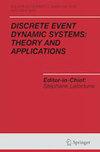Critique of Critique of Critique: Review of Roy Ben-Shai’s Critique of Critique
IF 1.6
4区 计算机科学
Q4 AUTOMATION & CONTROL SYSTEMS
Discrete Event Dynamic Systems-Theory and Applications
Pub Date : 2023-10-01
DOI:10.1353/tae.2023.a909217
引用次数: 0
Abstract
Critique of Critique of Critique: Review of Roy Ben-Shai’s Critique of Critique O. L. Silverman (bio) Roy Ben-Shai. Critique of Critique. Stanford, CA: Stanford University Press, 2023. 238 pp. $28.00 (pb). ISBN 9781503632684. The title of this review writes itself. This is precisely the guiding concern of Roy Ben-Shai’s Critique of Critique. CoC attends to the pervasiveness and automaticity of critique as an orientation of thought. Critiquing critique as a modality of thought does not mean negating, debunking, or objecting to it. Ben-Shai follows Kant’s sense of ‘critique’ in The Critique of Pure Reason; to critique critique means to articulate the conditions that give rise to (critical) knowledge. CoC aims to inhabit the paradox of its own enterprise. If critique is the act of pointing, Ben-Shai points both at the hand of the finger that is pointing and its environment. The book aims to bring the structural premises and essential features of critique into view to limit its scope, which Ben-Shai fears has become relentlessly repetitious and blind to its own repetitions. In associating the ubiquity and limitlessness of critique with prevailing cultural exhaustion, CoC joins a clade of recent works1 that sound critique’s shortcomings. These post-critical works did not escape criticism2 and are now known as another camp in the method wars of literary studies. Because critique is “a perennial and irreplaceable mode of thought,” there will be no utopia of post-critique (3). This book clarifies the limits of critique to clear a path for other orientations of critical thought. Orientation is, in fact, a central term of art in the book. “By orientation,” Ben-Shai means “not only a way of thinking but a way of being as well. An orientation is not only a way of being and thinking in the world but an orientation of the world itself” (6). Although critique has become the dominant mode of thought, especially in the humanities, it is nevertheless just one possible orientation. Orientation implies that reality can be “accessed in more than one way” (200). The orientation of critique is spectatorial, that of the viewer or judge, rather than, for example, that of the actor or the victim. Inhabiting the orientation of critique, the thinker is a passive viewer who relates to the world as a spectacle, and in doing so, is positioned toward the world in just this way. CoC begins with an overture that demonstrates the time-bending pleasures of philosophical reading as a full section tarries with a single Horkheimer sentence. The sentence is treated as a skeletal emblem of all critique’s structure. Critique’s orientation presumes that the world is in a sordid state, and its task is to perceive that state, organize the facts, and produce a theory. For Ben-Shai, the irrepressible wrongness of the world is constituted by the orientation of critique, for critique is precisely the vantage that can only perceive the wrongs of the world. Critique’s disposition is one of moralism, and its epistemology is a “staunch realism” that presumes “perception to be separate from reality” (27). The book is divided into two sections: “Aporias of Critique” and “Architectonics of Critique.” Part One aims to demonstrate the “constitutive reversibility [End Page 780] at the heart of critique itself” (18). Naming the spectacle, power, injustice, and external authority as objects of critique, Ben-Shai argues that the objects of critique are also its conditions of possibility. Critique depends on injustice because the spectatorial orientation of critique is the optic through which injustice is viewed. The work consciously aims to lead the reader into this whirlpool of aporia. Part Two, “Architectonics of Critique,” explores the ontological structures that sculpt critique’s frame. Critique possesses a unique orientation with ontological, epistemological, moral, and political entailments. Broadly, the ontology of critique is defined as a monocular orientation of the spectator in opposition to the world. In this section, Heideggerian etymological webs illustrate critique’s ontological orientation of spectatorship. To object is wedded to objectivity; the term accusation (ad causa) is bound to an argument about cause. In objection, critique incredulously testifies to an objective reality, rather than...《批判的批判》:罗伊·本·沙伊《批判的批判》述评
《批判的批判》:罗伊·本·沙伊《批判的批判》述评o·l·西尔弗曼(传记)罗伊·本·沙伊。批判的批判。加州斯坦福:斯坦福大学出版社,2023。238页,28.00美元(每盒)。ISBN 9781503632684。这篇评论的标题不言而喻。这正是罗伊·本·沙伊《批判的批判》的指导思想。CoC关注批判的普遍性和自动性,将其作为一种思想取向。批判批评作为一种思想形态并不意味着否定、揭穿或反对它。Ben-Shai在《纯粹理性批判》中继承了康德的“批判”概念;批判批判意味着阐明产生(批判性)知识的条件。CoC的目标是解决自身企业的悖论。如果批评是一种指指点点的行为,那么Ben-Shai既指向指指的那只手,也指向它所处的环境。这本书旨在将批判的结构前提和基本特征带入视野,以限制其范围,Ben-Shai担心它已经变得无情地重复,并且对自己的重复视而不见。在将批判的无所不在和无限性与流行的文化枯竭联系起来的过程中,《CoC》加入了最近的一批作品1,这些作品反映了批判的缺点。这些后批评作品并没有逃脱批评,现在被称为文学研究方法战争的另一个阵营。因为批判是“一种永恒的、不可替代的思维方式”,所以不会有后批判的乌托邦(3)。本书阐明了批判的局限性,为批判思维的其他方向扫清了道路。事实上,定位是书中艺术的中心术语。“定向”,本沙意指“不仅是一种思维方式,也是一种存在方式”。一种取向不仅是在世界上存在和思考的一种方式,而且是世界本身的一种取向”(6)。尽管批判已经成为占主导地位的思维方式,尤其是在人文学科中,但它仍然只是一种可能的取向。取向意味着现实可以“以不止一种方式获得”(200)。批判的取向是观赏性的,即观众或法官的取向,而不是,例如,演员或受害者的取向。在批判的取向中,思考者是一个被动的观察者,他把世界作为一个景观来看待,在这样做的过程中,他以这种方式定位于世界。《CoC》以一个序曲开始,展示了哲学阅读的时间弯曲乐趣,因为整个章节都停留在霍克海默的一句话上。这句话被视为所有批判结构的一个骨架符号。批判的取向假定世界处于一种肮脏的状态,它的任务是感知这种状态,组织事实,并产生一个理论。对于Ben-Shai来说,世界不可抑制的错误是由批判的取向构成的,因为批判恰恰是只能感知世界错误的优势。批判的倾向是一种道德主义,它的认识论是一种假定“知觉与现实是分离的”“坚定的现实主义”(27)。这本书分为两个部分:“批判的Aporias”和“批判的建筑学”。第一部分旨在证明“批判本身核心的构成可逆性”(End Page 780)。Ben-Shai将奇观、权力、不公和外部权威作为批判的对象,认为批判的对象也是其可能性的条件。批判依赖于不公正,因为批判的观赏性取向是观察不公正的视角。这部作品有意地将读者带入这种不安的漩涡。第二部分“批判的建筑学”探讨了塑造批判框架的本体论结构。批判具有独特的本体论、认识论、道德和政治取向。广义地说,批判的本体论被定义为旁观者与世界对立的单一取向。在本节中,海德格尔的词源学网说明了批判的观赏性本体论取向。客体与客观性相结合;“指控”(ad causa)一词与关于原因的论证有关。在反对意见中,批判难以置信地证明了客观现实,而不是……
本文章由计算机程序翻译,如有差异,请以英文原文为准。
求助全文
约1分钟内获得全文
求助全文
来源期刊
CiteScore
3.90
自引率
5.00%
发文量
13
审稿时长
>12 weeks
期刊介绍:
The research on discrete event dynamic systems (DEDSs) is multi-disciplinary in nature and its development has been dynamic. Examples of DEDSs include manufacturing plants, communication networks, computer systems, management information databases, logistics systems, command-control-communication systems, robotics, and other man-made operational systems. The state processes of such systems cannot be described by differential equations in general. The aim of this journal, Discrete Event Dynamic Systems: Theory and Applications, is to publish high-quality, peer-reviewed papers on the modeling and control of, and all other aspects related to, DEDSs. In particular, the journal publishes papers dealing with general theories and methodologies of DEDSs and their applications to any particular subject, including hybrid systems, as well as papers discussing practical problems from which some generally applicable DEDS theories or methodologies can be formulated; The scope of this journal is defined by its emphasis on discrete events and the dynamic nature of the systems and on their modeling, control and optimization.

 求助内容:
求助内容: 应助结果提醒方式:
应助结果提醒方式:


